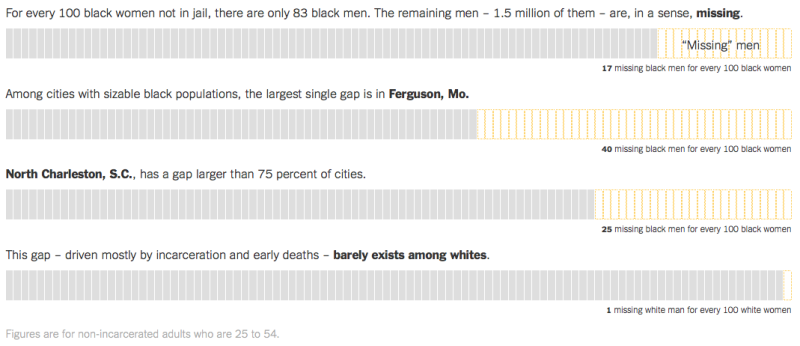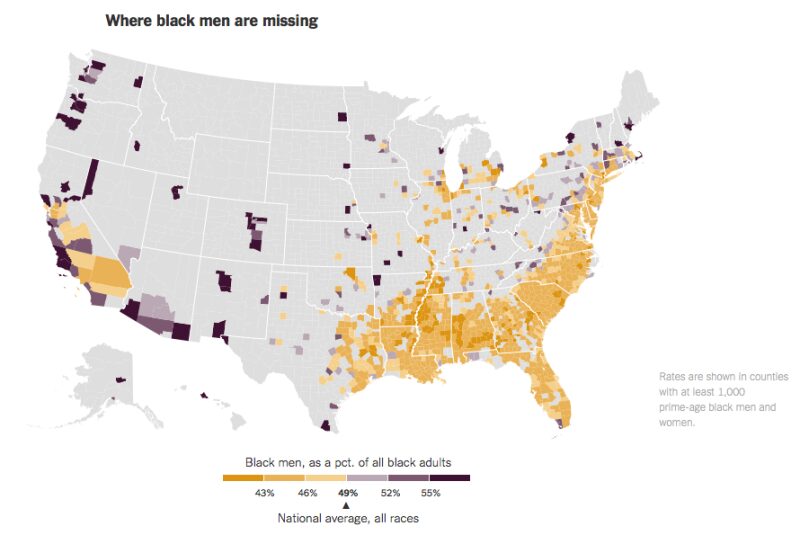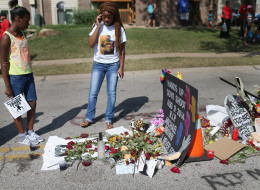1.5 Million Missing Black Men
Share
Explore Our Galleries
Breaking News!
Today's news and culture by Black and other reporters in the Black and mainstream media.
Ways to Support ABHM?
In New York, almost 120,000 black men between the ages of 25 and 54 are missing from everyday life. In Chicago, 45,000 are, and more than 30,000 are missing in Philadelphia. Across the South — from North Charleston, S.C., through Georgia, Alabama and Mississippi and up into Ferguson, Mo. — hundreds of thousands more are missing.
They are missing, largely because of early deaths or because they are behind bars. Remarkably, black women who are 25 to 54 and not in jail outnumber black men in that category by 1.5 million, according to an Upshot analysis. For every 100 black women in this age group living outside of jail, there are only 83 black men. Among whites, the equivalent number is 99, nearly parity.

African-American men have long been more likely to be locked up and more likely to die young, but the scale of the combined toll is nonetheless jarring. It is a measure of the deep disparities that continue to afflict black men — disparities being debated after a recent spate of killings by the police — and the gender gap is itself a further cause of social ills, leaving many communities without enough men to be fathers and husbands.
Perhaps the starkest description of the situation is this: More than one out of every six black men who today should be between 25 and 54 years old have disappeared from daily life….

And what is the city with at least 10,000 black residents that has the single largest proportion of missing black men? Ferguson, Mo., where a fatal police shooting last year led to nationwide protests and a Justice Department investigation that found widespread discrimination against black residents. Ferguson has 60 men for every 100 black women in the age group, Stephen Bronars, an economist, has noted.

The gap in North Charleston, site of a police shooting this month, is also considerably more severe than the nationwide average, as is the gap in neighboring Charleston. Nationwide, the largest proportions of missing men generally can be found in the South, although there are also many similar areas across the Midwest and in many big Northeastern cities. The gaps tend to be smallest in the West.
Incarceration and early deaths are the overwhelming drivers of the gap. Of the 1.5 million missing black men from 25 to 54 — which demographers call the prime-age years — higher imprisonment rates account for almost 600,000. Almost 1 in 12 black men in this age group are behind bars, compared with 1 in 60 nonblack men in the age group, 1 in 200 black women and 1 in 500 nonblack women.
Higher mortality is the other main cause. About 900,000 fewer prime-age black men than women live in the United States, according to the census. It’s impossible to know precisely how much of the difference is the result of mortality, but it appears to account for a big part. Homicide, the leading cause of death for young African-American men, plays a large role, and they also die from heart disease, respiratory disease and accidents more often than other demographic groups, including black women….
The disappearance of these men has far-reaching implications….
Read the full article here.
Read more Breaking News here.









Comments Are Welcome
Note: We moderate submissions in order to create a space for meaningful dialogue, a space where museum visitors – adults and youth –– can exchange informed, thoughtful, and relevant comments that add value to our exhibits.
Racial slurs, personal attacks, obscenity, profanity, and SHOUTING do not meet the above standard. Such comments are posted in the exhibit Hateful Speech. Commercial promotions, impersonations, and incoherent comments likewise fail to meet our goals, so will not be posted. Submissions longer than 120 words will be shortened.
See our full Comments Policy here.